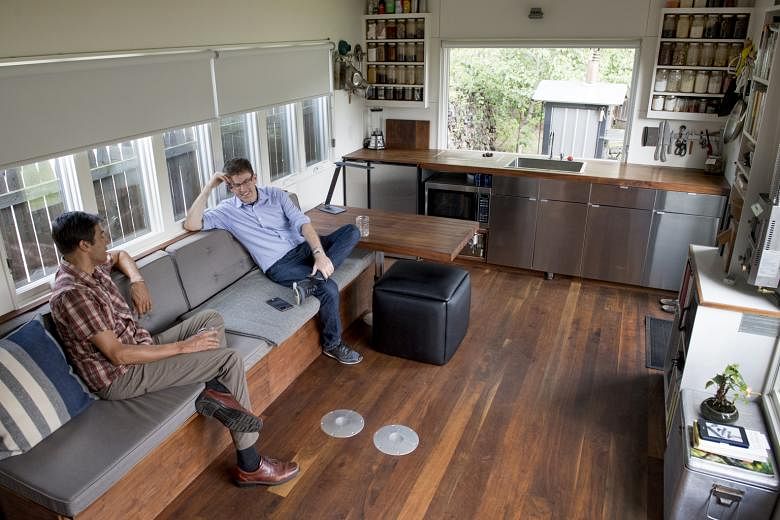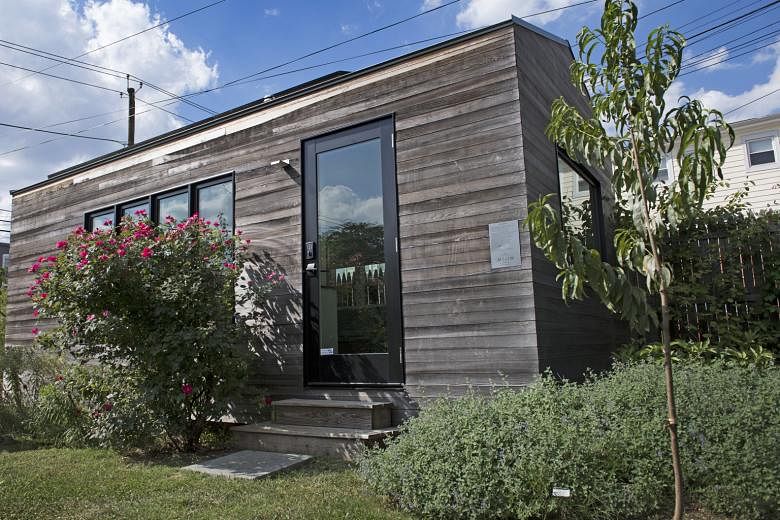WASHINGTON• The idea started on an empty alley lot in north-east Washington's little-known Stronghold neighbourhood.
Mr Brian Levy wanted to show those around him the benefits of minimal and environmentally friendly living.
So in 2012, he enlisted an architecture firm and builder to construct a 210 sq ft house on wheels - a particularly chic structure with stainless-steel kitchen countertops and maple floors.
It garnered media attention - a couple of spreads in glossy design magazines - and some quibbles from neighbours who parked on the empty lot.
It also raised questions over whether the city's zoning laws even permitted Mr Levy to use the lot for his tiny house experiment. Yes and no. He cannot use his micro home as a permanent residence.
But because he and other local urbanists lobbied the city to loosen its zoning restrictions, new laws that they say are friendlier to the tiny house movement went into effect on Tuesday.
These new zoning laws coincide with Mr Levy's latest business venture: He and his business associates have partnered a Pittsburgh-based manufacturer to build prefabricated versions of the house and deliver them to customers in Washington and elsewhere in the country.
"We're aiming to be the premier micro-house manufacturer in the country," Mr Levy said. "We're a business, but we're also mission- driven. We're focused on helping people live more simply, more cheaply and more ecologically."
Micro houses - or tiny homes - are part of an architectural movement encouraging simple and sustainable living.
The movement has gained steam in recent years as urbanists and hobbyists alike pitch the structures as a cheap solution to the expensive housing crisis plaguing many fast-gentrifying cities.
There is even a popular show based around the homes called Tiny House Hunters.
But critics of the movement contend that it focuses on single adults and overlooks vulnerable segments of the population, such as families and children, who experience poverty - and are often on the losing end of urban housing shortages.
When Mr Levy built his tiny home - a glamorous trailer he dubbed the Minim House - he wanted to see what the response in Washington would be.
Designed by Washington-based Foundry Architects, the house is "off-grid", meaning it requires no outside electrical outlets or plumbing for water, sewage, electricity or Internet.
He created a non-profit called Micro Showcase, where individuals and classrooms can schedule tours.
For a while, he experimented with creating a community of tiny houses on the lot called Boneyard Studios, which disbanded amid controversy in 2014.
There was a rift between Mr Levy and the two other micro-home owners on the lot, which included questions over the sometimes smelly disposal of sewage, since the homes are not connected to sewage treatment.
The lot now includes four micro structures, a garden and other projects that friends are working on and which people can tour.
Together, these projects showed Mr Levy that there is interest in tiny houses and that the venture could be worth a bigger investment.
He created Minim Built - initially called Minim Homes - where he and his two partners sold 88 plans of his flagship micro house for US$495 (S$666) each.
Mr Chris VanArsdale, one of the co-owners, said that he fielded questions last summer from interested buyers and that they considered selling.
But ultimately, they decided to see if they could create a business model around selling a version of the Minim House on their own.
Customers can now order one of the houses - with or without wheels - for US$71,000, plus shipping, and have it delivered ready for moving in.
At 265 sq ft and 3.65m wide, the Minim House Mr Levy is selling is slightly bigger than the one currently showcased on his Stronghold lot. The company is hoping to sell at least one house a month in its first year.
Mr Levy said their target customer includes retirees looking to downsize, cramped D.C. homeowners looking for extra space or rural cabin dwellers.
"It's ideal for one, possibly two people, depending on how much you love them," Mr Levy said.
"It's low-maintenance."
It is also designed to be as functional and liveable as possible, he added.
There are large windows and a full kitchen. A cosy table for two pushed against a wall can swing to the middle of the house for an eight-person dinner party.
There is a couch that can double as a bench for the table and a 96-inch projection screen. A queen-size trundle bed pulls out when needed and there are bookshelves, closets, a work area and a bathroom. And they are all small.
Mr Levy said it will take a maximum of three months from order to delivery.
WASHINGTON POST


